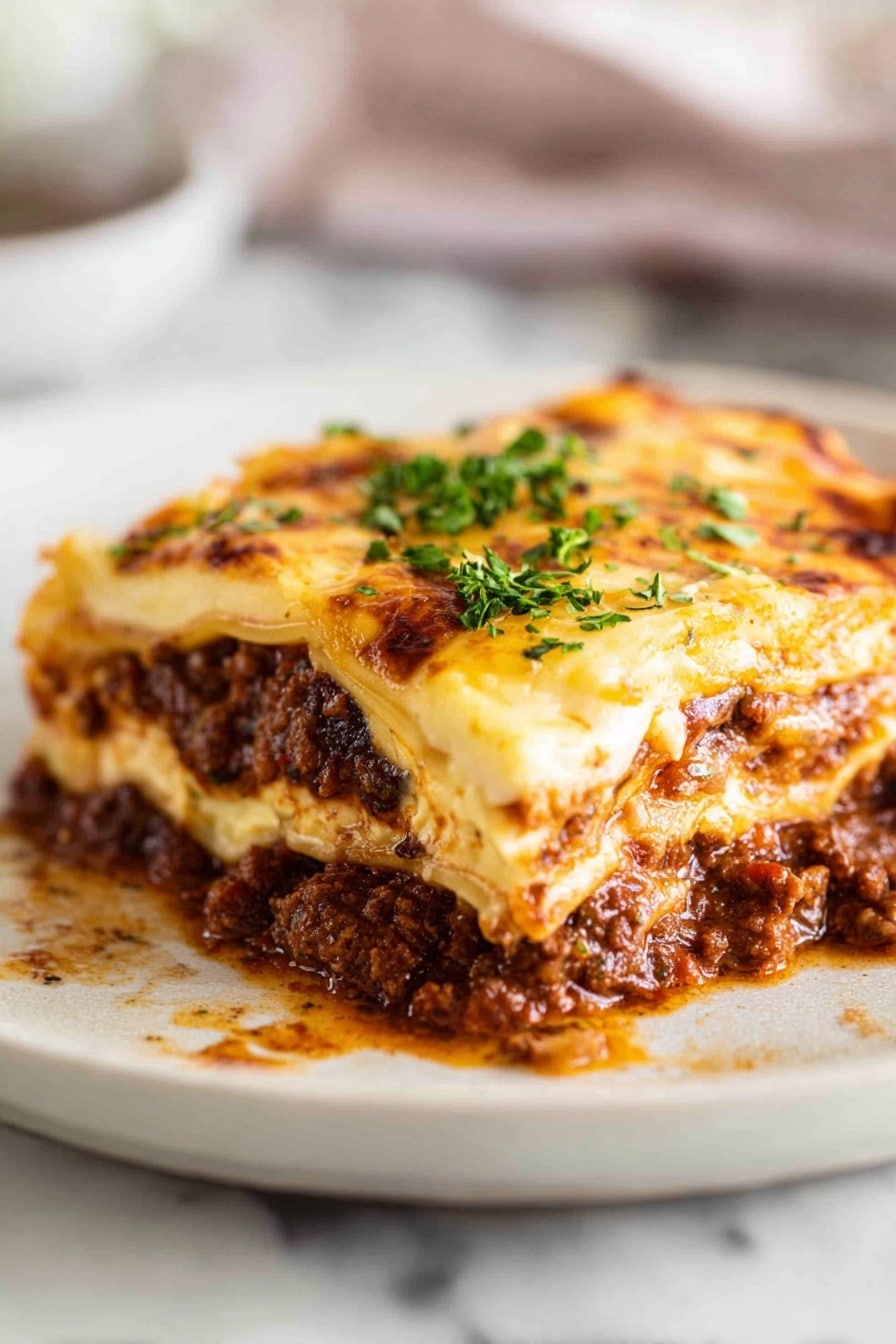If you’re craving comfort food that warms the soul, you’re in the right place. This Classic Beef Lasagna with Rich Ragu Recipe is one of those dishes I find myself making whenever I want to impress friends or just treat my family to a hearty, crowd-pleasing meal. It’s packed with tender, slow-cooked ragu, a velvety béchamel sauce, and layers of cheesy goodness that come together to create pure magic. Trust me, once you try this, it’ll become a go-to in your recipe box.
Why You’ll Love This Recipe
- Authentic Italian Flavor: Slow-cooked ragu and béchamel combine for that classic taste without shortcuts.
- Perfectly Layered Texture: Four layers of pasta alternate with rich meat sauce and creamy cheese.
- Family Favorite: My loved ones literally go crazy for this; it’s comfort on a plate.
- Make-Ahead Friendly: You can prep it in advance and bake when ready — stress-free dinner plans!
Ingredients You’ll Need
Choosing the right ingredients is key here — fresh veggies, good quality beef, and proper cheeses bring this Classic Beef Lasagna with Rich Ragu Recipe alive. I always opt for freshly shredded cheese over pre-shredded since it melts better, and full-fat milk for my béchamel to get that silky smooth texture.
- Olive oil: Use good-quality extra virgin olive oil to gently sauté your aromatics and add depth.
- Onion: White, yellow, or brown works fine; just finely chop for that base flavor.
- Carrot: Peeled and diced very small; it adds sweetness and balances the tomato acidity.
- Celery stick: Another subtle flavor enhancer that softens in the ragu.
- Garlic cloves: Minced fresh garlic is a must for that classic Italian kick.
- Beef mince: I prefer lean ground beef for rich flavor without too much grease.
- Canned crushed tomato: Use good-quality to get the best ragu flavor.
- Tomato paste: Adds concentrated tomato richness.
- Pinot noir red wine: Or any dry red — it deepens the sauce and tenderizes the meat beautifully.
- Beef bouillon cubes: Crumbled to enhance meaty flavor.
- Bay leaves: Essential for that aromatic, subtle earthiness.
- Dried thyme and oregano: The classic Italian herbs that round out your ragu.
- Worcestershire sauce: A secret umami booster I learned to always add for complexity.
- Sugar (optional): Just a teaspoon or two to tame acidity if needed.
- Salt and black pepper: Always season carefully to taste.
- Butter: The base of your béchamel — gives a rich creaminess.
- Flour: Whisked in to thicken the béchamel sauce.
- Milk: Full fat works best for creamy texture, but low fat will do in a pinch.
- Gruyere or Colby cheese: I love gruyere here — it melts beautifully and adds a subtle nuttiness.
- Nutmeg: A pinch in the béchamel gives a lovely warm aroma.
- Lasagna sheets: Fresh sheets if you can find them; they cook up tender and perfect.
- Mozzarella cheese: Freshly shredded for that gooey top layer.
- Basil or parsley (optional): For that fresh green pop and herbal brightness at serving.
Variations
One of the reasons I love this Classic Beef Lasagna with Rich Ragu Recipe is because it’s so versatile. I’ve played around with it quite a bit, and you should feel free to tweak it to suit your taste or dietary needs.
- Vegetarian Version: Swap the beef for a mix of mushrooms and lentils — personally, I was surprised how hearty it still feels!
- Spicy Kick: Add chili flakes to your ragu if you like a bit of heat; my husband swears by this every time.
- Cheese Swaps: Use a mix of mozzarella and parmesan or even Monterey Jack — whatever melts best for you.
- Gluten-Free: Use gluten-free lasagna sheets and substitute the flour in béchamel with cornstarch; I’ve tested this for friends with allergies and it turned out great.
How to Make Classic Beef Lasagna with Rich Ragu Recipe
Step 1: Building Your Flavor Base
Start by heating a tablespoon of olive oil in a large pan over medium heat. Toss in your finely chopped onion, carrot, and celery — this soffritto is the heart of your ragu. Sauté gently until soft and fragrant, about 8-10 minutes, stirring occasionally so nothing browns too fast. Then add the minced garlic and cook for another minute. This slow base-building technique helps develop deep layers of flavor that really shine later.
Step 2: Browning the Beef
Next, increase the heat a bit and add your beef mince. Break it up well with your spoon and cook until it loses its pink color and starts to brown. Don’t rush this step — those browned bits are pure flavor gold! If you see too much liquid, you can tilt the pan and carefully spoon off excess fat, but leave enough for richness.
Step 3: Creating the Rich Ragu Sauce
Stir in your crushed tomatoes, tomato paste, crumbled beef bouillon cubes, bay leaves, thyme, oregano, Worcestershire sauce, and red wine. Bring everything to a gentle simmer, then lower the heat and cover partially. Let it slow-cook for at least 3 hours, stirring occasionally. I usually leave mine simmering while I tackle other kitchen tasks or relax with a cup of coffee—this slow cooking is key for tender, melt-in-your-mouth beef and thick, luscious sauce.
Step 4: Making the Creamy Béchamel Sauce
While the ragu is doing its thing, melt butter in a saucepan over medium heat. Whisk in the flour and cook for 1-2 minutes, making a roux — this removes the raw flour taste. Slowly add milk, whisking constantly until the sauce thickens and is silky smooth. Season with salt, pepper, and a pinch of nutmeg. Then stir in your shredded gruyere or other cheese until melted and creamy. This sauce adds that indulgent richness that balances the robust ragu perfectly.
Step 5: Layering Your Lasagna
In a deep baking dish, start with a thin layer of béchamel sauce. Then lay down your fresh (or dried) lasagna sheets — no pre-boil needed if fresh. Add a layer of ragu, followed by more béchamel. Repeat until you have 4 layers of pasta, finishing with a generous layer of béchamel mixed with mozzarella on top. This layering ensures each bite gets a perfect balance of textures and flavors.
Step 6: Bake to Golden Perfection
Preheat your oven to 180°C (350°F) and bake the assembled lasagna, uncovered, for 45-60 minutes until bubbly and golden on top. Let it rest for at least 15 minutes before slicing — this helps it set and makes serving much easier. Trust me, the wait is worth it!
Pro Tips for Making Classic Beef Lasagna with Rich Ragu Recipe
- Sauté Low and Slow: Don’t rush the soffritto stage; soft veggies release sweetness that’s huge for flavor depth.
- Simmer Your Ragu Well: The longer you let it cook, the more tender the meat and richer the sauce get — I go at least 3 hours!
- Fresh Cheese Matters: Whenever possible, shred your own cheese for that smooth melt rather than using pre-shredded ones with additives.
- Don’t Skip the Rest Time: Let your lasagna rest after baking to avoid a messy, runny slice—patience pays here.
How to Serve Classic Beef Lasagna with Rich Ragu Recipe

Garnishes
I usually sprinkle freshly chopped basil or parsley over the top for a fresh, herby contrast to the rich layers. Sometimes, a little extra grated parmesan at the table never hurts — it adds that salty, nutty finish that elevates each bite.
Side Dishes
To balance the richness, I love serving this lasagna with a crisp green salad dressed simply with lemon and olive oil, or some roasted seasonal veggies. A crusty garlic bread is practically mandatory in my book — it’s perfect for mopping up any leftover sauce.
Creative Ways to Present
For special occasions, I’ve assembled individual lasagna portions in small ramekins — it feels fancy but is surprisingly easy. Another fun idea is layering it in a glass casserole dish for a rustic, beautiful look that shows all the vibrant layers. Either way, it makes dinner feel like a celebration.
Make Ahead and Storage
Storing Leftovers
I usually cover leftovers tightly with plastic wrap and store them in the fridge for up to 3 days. This lasagna actually tastes even better the next day after the flavors have had some time to meld. Just be sure to cool it completely before refrigerating to avoid soggy pasta.
Freezing
This Classic Beef Lasagna with Rich Ragu Recipe freezes beautifully. I like to assemble the whole dish and freeze it raw, then bake from frozen adding extra 10-15 minutes to the baking time. Alternatively, freeze cooked slices individually for quick reheat lunches. Either way, freezing is a lifesaver for busy weeks.
Reheating
To reheat, I cover the lasagna with foil and warm it in a 160°C (325°F) oven until heated through — usually about 20-25 minutes. This gentle reheating keeps the cheese melty and prevents drying out. Microwave works in a pinch but the texture isn’t as nice.
FAQs
-
Can I use dried lasagna sheets instead of fresh?
Absolutely! If you’re using dried sheets, soak them briefly in warm water or boil them according to package instructions before assembling. Fresh pasta tends to be more tender and requires less prep, but dried works well too and is sometimes more convenient.
-
What type of wine is best for the ragu?
I recommend using a dry red wine like Pinot Noir, Chianti, or Merlot. The wine adds depth and complexity but make sure it’s one you’d enjoy drinking since the flavor concentrates in the sauce as it simmers.
-
Is there a way to make this recipe faster?
You can make the ragu in a pressure cooker to reduce cooking time significantly or use store-bought ragu in a pinch. However, the traditional slow simmer is what makes this lasagna truly special, so I encourage you to savor the process if you can!
-
Can I substitute the gruyere cheese?
Definitely. Gruyere gives a nutty, creamy melt, but you can use Colby, cheddar, Monterey Jack, or even parmesan. Just choose cheeses that melt easily to keep that luscious béchamel texture.
Final Thoughts
I absolutely love how this Classic Beef Lasagna with Rich Ragu Recipe turns out every time — it’s the perfect comfort food and a real crowd-pleaser. When I first made it, I was amazed at how that slow-cooked ragu and creamy béchamel created layers of flavor unlike anything else. My family goes crazy for it, and I bet yours will too. Give yourself the gift of some kitchen patience here — it’s worth every minute. So go ahead, try this recipe, and cue the compliments!
Print
Classic Beef Lasagna with Rich Ragu Recipe
- Prep Time: 20 min
- Cook Time: 240 min
- Total Time: 260 min
- Yield: 10 servings 1x
- Category: Main Course
- Method: Baking
- Cuisine: Italian
Description
This traditional Italian lasagna recipe features a slow-cooked ragu bolognese paired with a creamy béchamel sauce, layered with fresh lasagna sheets and melted cheeses. Rich and comforting, this dish requires some patience but rewards with tender meat sauce and velvety texture, making it perfect for hearty family meals or special occasions.
Ingredients
Meat Sauce (Ragu Bolognese)
- 1 tbsp olive oil
- 1 onion, finely chopped (white, yellow or brown)
- 1 medium carrot, peeled and very finely diced
- 1 celery stick, very finely diced
- 2 garlic cloves, minced
- 1 kg / 2 lb beef mince (ground beef)
- 800g / 28 oz canned crushed tomato
- 1/4 cup tomato paste
- 1 cup pinot noir red wine or other dry red wine
- 3 beef bouillon cubes, crumbled
- 2 bay leaves, dried or fresh
- 1/2 tsp dried thyme
- 1/2 tsp dried oregano
- 2 tsp Worcestershire sauce
- 1 – 2 tsp sugar (if needed)
- 1/2 tsp salt
- Black pepper to taste
Béchamel Sauce
- 60g / 4 tbsp butter
- 1/2 cup flour
- 4 cups milk (preferably full fat but low fat ok)
- Pinch of freshly ground nutmeg
- Salt and pepper to taste
- 2 cups Gruyere or Colby cheese, shredded (or cheddar, Monterey Jack, or 1 cup / 100g shredded Parmesan)
Assembly
- 350g / 12 oz fresh lasagna sheets or 250g / 8 oz dried
- 1 1/2 cups mozzarella cheese, shredded
- Finely chopped basil or parsley for garnish (optional)
Instructions
- Prepare the Ragu: Heat olive oil in a large pan over medium heat. Add finely chopped onion, carrot, and celery; sauté until softened. Add minced garlic and cook briefly. Stir in the beef mince and cook until browned evenly. Pour in the red wine and let it reduce slightly. Add crushed tomatoes, tomato paste, crumbled beef bouillon cubes, bay leaves, dried thyme, oregano, Worcestershire sauce, salt, and pepper. Add sugar as needed to balance acidity. Reduce heat to low and simmer gently for about 3-4 hours, stirring occasionally until the sauce is thick and rich.
- Make the Béchamel Sauce: In another saucepan, melt butter over medium heat. Whisk in flour and cook for a minute to form a roux without browning. Gradually whisk in milk to prevent lumps. Cook, stirring constantly, until the sauce thickens and coats the back of a spoon. Season with nutmeg, salt, and pepper. Remove from heat and stir in shredded Gruyere or Colby cheese until melted and smooth.
- Preheat Oven and Prepare Pasta: Preheat the oven to 180°C (350°F). If using fresh lasagna sheets, ensure they are ready to use. For dried sheets, you may want to soften slightly per package instructions.
- Assemble the Lasagna: In a large baking dish, spread a thin layer of ragu on the bottom. Place a layer of lasagna sheets over the sauce. Add a layer of ragu, then a layer of béchamel sauce. Sprinkle a portion of shredded mozzarella cheese over the béchamel. Repeat this layering three to four times, finishing with a béchamel topping and mozzarella cheese on top.
- Bake: Cover the lasagna dish with foil and bake in the preheated oven for 30-40 minutes. Remove the foil in the last 10-15 minutes of baking to allow the top to brown and cheese to melt and bubble. Let the lasagna rest for about 10-15 minutes before serving to set properly.
- Garnish and Serve: Sprinkle finely chopped basil or parsley over the lasagna just before serving for a fresh, aromatic touch.
Notes
- This recipe features a traditional Italian lasagna with slow-cooked ragu and béchamel sauce—no ricotta cheese, which is common in American-Italian versions.
- Patience is essential as the ragu simmers slowly to develop deep flavors and tender meat texture.
- Makes 8 giant or 10 normal servings with 4 layers of pasta and 3 layers of sauce and cheese.
- You can increase to 5 layers by scaling the recipe by 25% and using a deeper pan for more servings.
- Shredding your own cheese yields better melting and texture compared to pre-shredded options.
- Optionally add sugar to the ragu to balance tomato acidity depending on the canned tomatoes used.
Nutrition
- Serving Size: 398 g
- Calories: 594 kcal
- Sugar: 11 g
- Sodium: 979 mg
- Fat: 29 g
- Saturated Fat: 15 g
- Unsaturated Fat: 12 g
- Trans Fat: 1 g
- Carbohydrates: 40 g
- Fiber: 2 g
- Protein: 39 g
- Cholesterol: 146 mg



